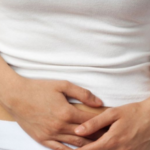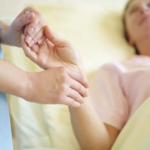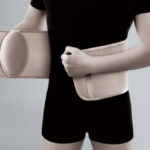Bandage for inguinal hernia in women
With an inguinal hernia in women, a part of the intestine, omentum, bladder, uterus or ovaries comes out under the skin in the genital area. Such a disease is defined externally as a rounded formation, reducible with light pressure.
A hernia is treated by a surgeon, the main method is hernioplasty. In addition to the operation, conservative methods are also used to prevent complications, including an inguinal bandage.
A special supporting belt is fixed in the area of the defect so that the pads (dense plates) press on the defect, preventing it from “falling out” to the outside. Such a device is selected by the doctor after the discovery of a hernia, before the operation and after hernia repair.
Women's bandage for inguinal hernia is recommended to everyone without exception in the absence of complications of the disease. The belt is worn during any physical work, with the appearance of soreness and during pregnancy to prevent protrusion.
The bandage is extremely important after inguinal hernia surgery in the early period of rehabilitation, when women are healing tissues and it is necessary to exclude stress on the operated area.
Why an inguinal bandage for a hernia
In women, inguinal hernia is diagnosed less frequently, due to anatomical features, in particular, the narrow opening of the inguinal canal. In addition, in men, the aponeurosis of the oblique muscle is weaker, and the collagen fibers of the inguinal ring are less dense. But, despite this, women can suffer from an inguinal hernia against the background of external and internal adverse factors: high intra-abdominal pressure, heavy loads, injuries, muscle separation during pregnancy.
The main task of the bandage for hernia in women will be to fix the protrusion in one position, when the hernial sac is set and there is no compression of the internal organs.
The belt not only prevents pinching, but also reduces the severity of symptoms, removing pain while walking, bending over, coughing and other conditions when muscle tension occurs.
It makes sense to use a bandage when other conditions for prevention are also met:
- diet - the task of proper nutrition in case of a hernia will be to prevent constipation and bloating, which can become a factor of infringement, but a strict diet is prescribed by a doctor after surgery;
- performing therapeutic exercises - exercise therapy for a disease in women can be harmful, especially at an advanced stage of the pathology, when several organs have left their place, but in some cases the doctor will recommend gymnastics to strengthen the muscles of the anterior abdominal wall even before surgery, and after that it will already become an important condition for rehabilitation ;
- treatment of pathologies of the gastrointestinal tract, pelvic organs and the respiratory system - this is important to exclude conditions that lead to high intra-abdominal pressure.
A comfortable and inconspicuous bandage for inguinal hernia will be the best way to prolong the stage of the pathology at which it was diagnosed. At the same time, it is important to understand that the belt is not a remedy, it cannot affect the protrusion itself, returning the organs to their place.
Long-term use of the bandage will only harm the woman, because it is important to strengthen the muscles to prevent relapse, and the constant wearing of the belt will only contribute to atrophy and loss of muscle tone, to the point that without this additional device it will no longer be possible to perform daily activities.
Before surgery
Surgical treatment of pathological protrusion of organs is mandatory, but there are conditions in which the operation has to be postponed for some time. For this period, conservative therapy is prescribed. This also applies to the period of gestation, because surgical intervention is undesirable for pregnant women, unless there are emergency indications.
Before the operation, a special belt is not always prescribed, there are restrictions on its use, including the serious condition of the patient. When there are no complications, there is always a risk of their occurrence, and then the use of the belt for several hours a day during physical work will be justified by reducing the load on the protrusion area. Wearing a belt all day and leaving it overnight is strongly discouraged.
The bandage belt is useful for women with a hernia in the groin due to the following effects:
- reduction of pressure on the area of protrusion during movement and muscle tension;
- reduction of stretching of damaged muscles (including during pregnancy);
- providing rest to the diseased area for rapid tissue recovery after surgery;
- reducing pain by distributing the load on individual muscles.
You need to wear such a belt for several hours a day, and only during activity. At night and at rest, the bandage must be removed so that the muscles rest, there is no squeezing and blood circulation is not disturbed.
The protrusion in the groin in women can be bilateral, then it is extremely important to select the appropriate bandage with two elastic inserts.
After operation
A postoperative bandage is always needed, and it is selected especially carefully, because it is important not only to fix the diseased area, but also to protect it from rubbing, accidental injury and infection. Such a belt should be soft, hypoallergenic, not too tight, but at the same time fit snugly in the wound area. A bandage is put on only after the postoperative scar is closed with an antiseptic dressing, which must be changed several times a week or even every day, depending on the characteristics of wound healing.
The best option after the operation would be a bandage in the form of Velcro swimming trunks, which is easy to put on and take off without the risk of skin damage. Such a product is practically invisible under clothes, so you can do your usual things in it without psychological and physical discomfort.
It is necessary to put on the postoperative belt in the supine position, when the muscles are relaxed and the bandage is well fixed. The bandage model will not be of fundamental importance, but you need to pay attention to the method of fixation. Less convenient options would be products with buckles, fasteners, various buttons and hooks.
Indications and contraindications
The bandage is indicated for the risk of hernia incarceration before surgery and for the prevention of postoperative complications after removal of the defect.
But such a belt also has contraindications:
- irreducible and strangulated hernia;
- neoplasms in the groin area;
- allergy to the material of the product;
- dermatological diseases in the acute period;
- bleeding from a postoperative wound;
- pregnancy (there are exceptions, the decision is made by the attending physician).
How to choose a bandage
Standard inguinal bandages are made of elastic hypoallergenic materials that absorb moisture well and do not irritate the skin. They have one or two inserts for use in unilateral and bilateral hernia. Pelots in the form of thin plates are trimmed with soft material, but they are dense in themselves, which ensures reliable fixation of the defect area.
There are separate models for children and adults, but they are all unisex, that is, they are suitable for men and women. An important selection criterion will be the side of the protrusion, because the belts are right - and left-sided, but there are also universal models with removable inserts.
The material of the product is no less important, it is better to select natural fabrics, which will provide good ventilation, eliminate the accumulation of moisture and irritation. In no case should you buy a bandage without trying it on. If the belt is not tight enough, it will make it useless, and a tight bandage will only bring the moment of infringement of the protrusion closer.
Complications of a hernia without treatment
As the practice of surgeons shows, many patients do not take into account the importance of wearing a bandage, diet and rest. Such an attitude towards one's condition leads to the development of severe complications.
Prevention is extremely important with a hernia due to the following conditions:
- Suppuration and divergence of the seam.
- Recurrence of the disease (can often recur, and each time surgery is needed).
- The appearance of hematomas.
- Trauma of blood vessels and nerves (decrease or complete loss of sensitivity in the thigh area).
- Deep vein thrombosis.
What can lead to complications:
- rejection of the bandage, as well as its constant wearing;
- non-compliance with the diet;
- respiratory diseases (increased intra-abdominal pressure when coughing);
- heavy physical work;
- sudden movements, accidental injuries.
After surgery, there are fewer dangers, but there is always a risk of re-development of an inguinal hernia, as evidenced by the appearance of a protrusion and a recurrence of symptoms.
The bandage helps to avoid relapse if all recommendations are followed in the postoperative period. Immediately after the operation, you need to wear it daily, taking it off for several hours and during sleep, then put on the belt if necessary, while doing housework, walking, exercising.










